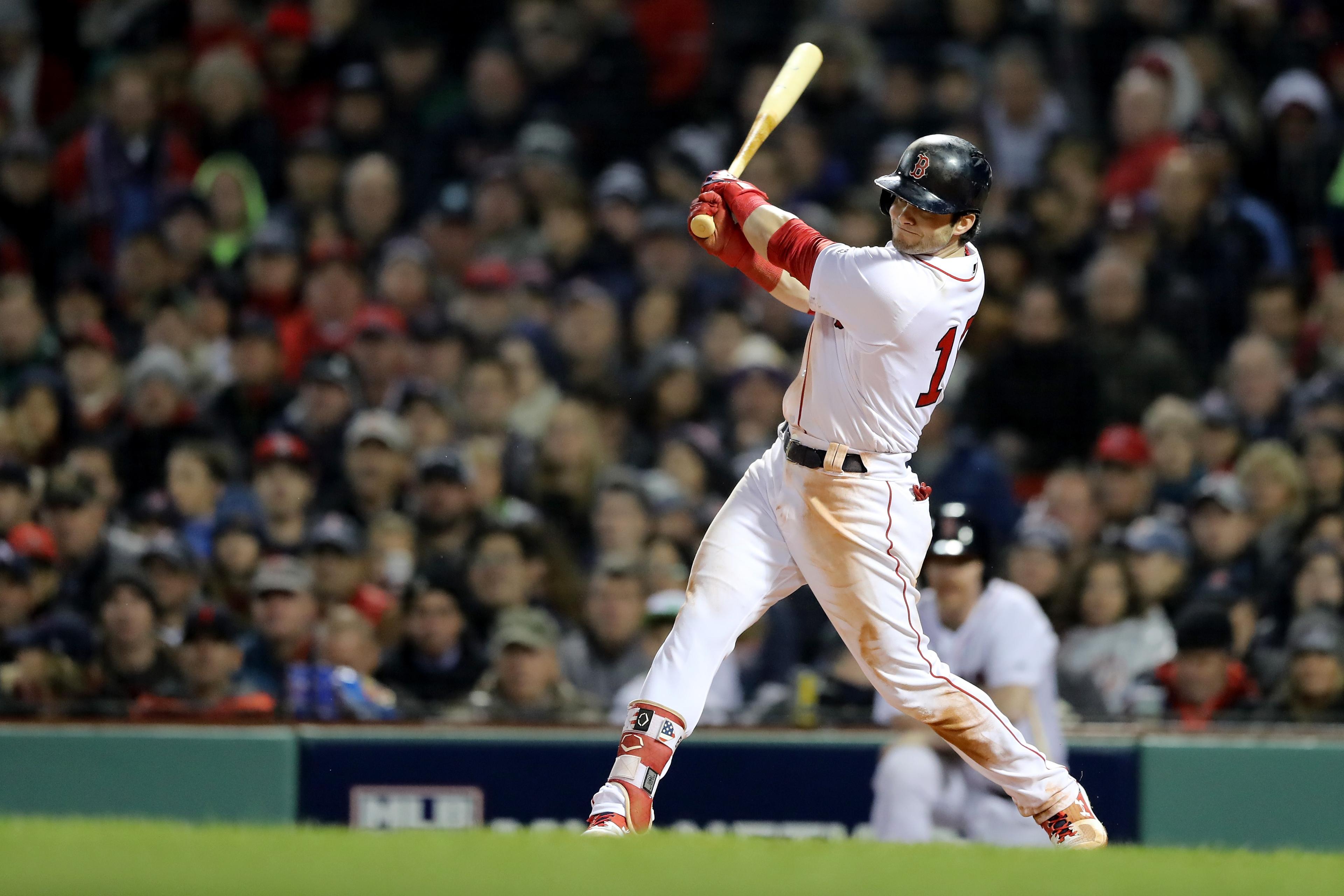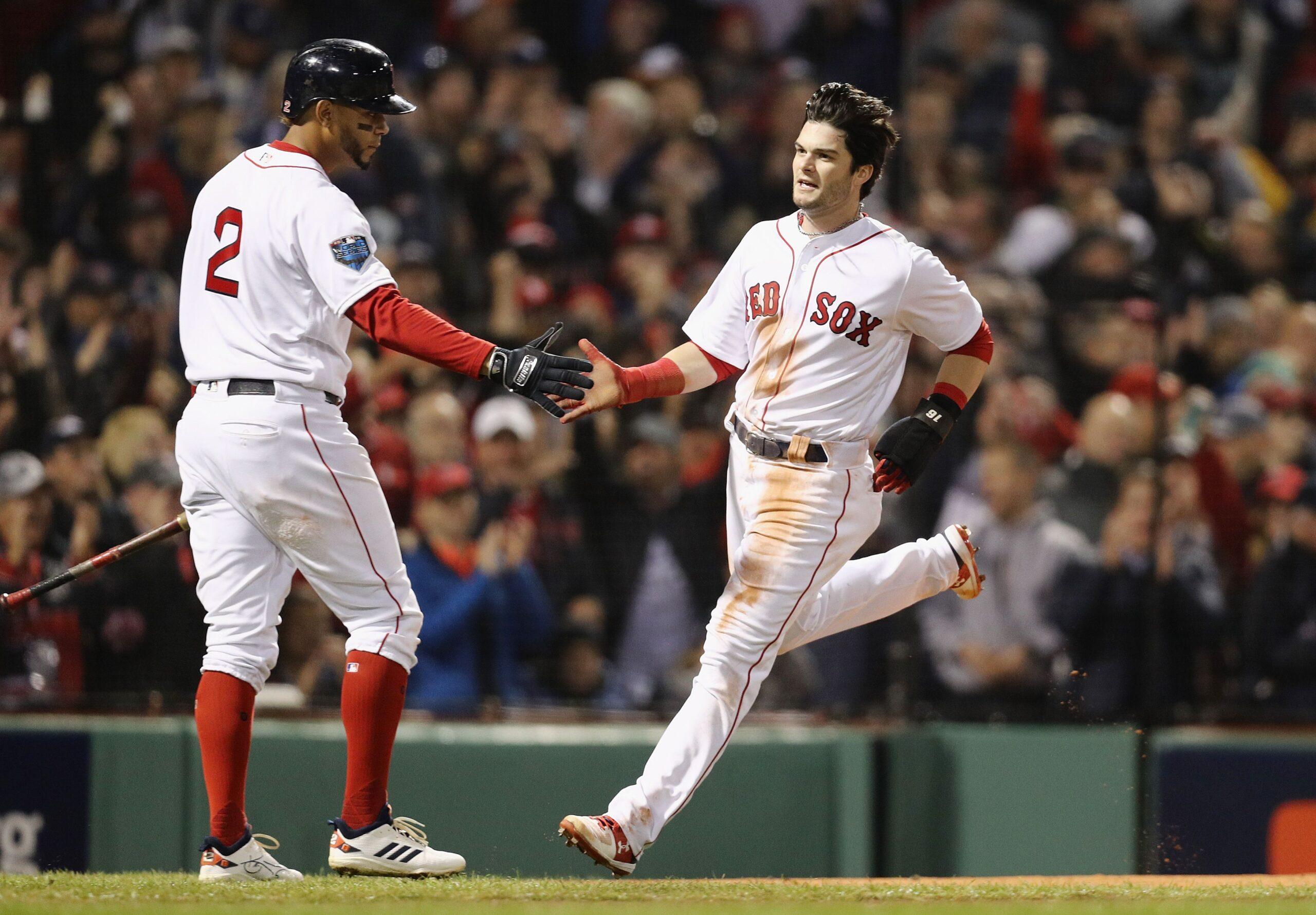The World Series Might Turn Andrew Benintendi Into a Star
Although Benintendi was a top-10 draft pick and although he’s been an above-average big leaguer since the moment he joined the Red Sox, he’s been overshadowed at every turn by someone more spectacular. But if Game 1 of the World Series is any indication, that won’t be true for much longer.
Tom Verducci, working as a field reporter for Fox during the World Series, needed a Red Sox player to interview immediately after Boston closed out its 8-4 Game 1 victory against the Dodgers. The postgame TV interview has turned into an informal “player of the game award,” often granted to whoever drove in the winning run or made the game-deciding catch.
Verducci’s first interview subject was Red Sox outfielder Andrew Benintendi, who scored three runs and tagged Dodgers pitchers for four hits, making him just the third Red Sox player to get four hits in a World Series game. The first three of those hits came off Clayton Kershaw, making Benintendi just the fourth left-handed hitter to get three hits off Kershaw in a game and the 44th left-handed hitter to get at least three hits off Kershaw in his career. It’s quite an achievement, because Kershaw kills lefties: Bryce Harper also has three career hits off Kershaw, but in 28 plate appearances to Benintendi’s three. Todd Helton, whose last MLB season coincided with Benintendi’s senior year of high school, is still tied for sixth in career hits off Kershaw by left-handed batters.
Heading into the playoffs, Benintendi wasn’t a household name, but his exploits this October—his diving catch to end Game 4 of the ALCS saved the game and gave Boston a 3-1 series lead—are turning him into a star. It’s a little weird that Benintendi hasn’t had that moment already, since he’s been excellent over his first two full seasons on a successful, high-profile team, but everything about Benintendi’s path to this point has been a little weird.
The Red Sox have a disconcerting amount of star power. Mookie Betts and J.D. Martinez will likely finish at or near the top of the MVP voting this year. Dustin Pedroia, who isn’t on the postseason roster but is still to a large extent the face of the franchise, already has one of those. David Price and Rick Porcello have Cy Young awards, and while Chris Sale doesn’t, he’s on track for a Hall of Fame career, and so is closer Craig Kimbrel, and, possibly, second baseman Ian Kinsler. And hell, it’s early, but so is Betts. Even the team’s supporting cast has grabbed headlines this postseason: center fielder Jackie Bradley Jr. took home ALCS MVP honors, while utilityman Brock Holt hit for the cycle in the ALDS and embattled infielder Eduardo Núñez delivered the biggest hit of Game 1, a three-run pinch-hit homer off Alex Wood that put the game out of reach.
There’s just not a lot of air for Benintendi, who’s been capable but not spectacular over two-plus big league seasons.
Benintendi came to the Red Sox by way of the 2015 draft. He was the no. 7 overall pick, an accomplishment that would’ve been unthinkable just three months earlier. Entering his sophomore season at Arkansas, Benintendi wasn’t on anyone’s radar. That’s partially because most players at four-year colleges aren’t eligible to be drafted as sophomores, but Benintendi was because he turned 21 within 40 days of the draft. (It sounds weird, but given the massive player pool of the MLB draft, oversights like that happen from time to time—in 2016, Nevada outfielder T.J. Friedl, a potential second-round pick, fell through all 40 rounds and went undrafted because of uncertainty about his eligibility.)
But more importantly, Benintendi wasn’t much of a prospect. He was good enough to start as a true freshman at a big school, but he hit just .276/.368/.322, with 17 stolen bases in 21 attempts. Out of high school, Benintendi had merited just a token 31st-round selection from his hometown Cincinnati Reds, and fast outfielders who can take a walk but have no power grow on trees in college baseball—through one college season, there was just nothing special about Benintendi.
That changed in a hurry. Benintendi, who’s listed at just 5-foot-10 and 170 pounds, became one of those short, athletic players with a good hit tool who develops a power stroke out of nowhere, just like Ozzie Albies, José Altuve, and countless others. After recording just 10 extra-base hits, eight of them doubles, as a freshman, Benintendi hit 20 home runs in 65 games in his draft year, more than doubling his slugging percentage to a staggering .717.
After the power came, Benintendi retained all the skills that made him a viable college player even when he hit like Dee Gordon. He still had the range to play center field, the wheels to steal 20 bases a year, and the batting eye to walk more than he struck out, in addition to baseball sense that helped his tools play up in every aspect of the game. Add in a suddenly staggering power tool—Benintendi’s 20 home runs led Division 1 college baseball, and his slugging percentage led all major conference players with at least 10 at-bats—and Benintendi looked like a well-rounded big league starter at the very least, perhaps even an MVP-caliber player if everything broke right.
Not everything has broken right for Benintendi so far, but a lot of things have. He made his big league debut just 14 months after being drafted, and immediately claimed Boston’s starting left-field spot as his own by hitting .295/.359/.476 in 118 plate appearances in 2016. In 2017 and 2018, his first two full big league seasons, Benintendi has posted a 113 OPS+ (58th out of 121 qualified hitters), and 6.5 bWAR (56th among position players over the past two years). In 2018, he hit .290/.366/.465 with 21 stolen bases in 24 attempts, finishing in the top 30 in MLB in OBP, extra-base hits, and stolen bases.
Being in the top 60, or even in the top 30, position players in MLB is good, but it’s not exciting. Benintendi is an above-average starting left fielder by anyone’s standards, and he got there by being above-average in just about every facet of the game. But he’s not really exceptional at anything, except maybe stolen base efficiency, which isn’t as attention-grabbing as, say, home runs or even just total stolen bases.

Benintendi’s been the kind of player you have to study a little to appreciate; the context of his numbers make his performance look more impressive. For instance, Benintendi is just wrapping up his age-23 season and has more than 1,400 big league plate appearances, and is in his third postseason as an everyday player. George Springer, Aaron Judge, Rhys Hoskins, and Lorenzo Cain were all about the same age Benintendi is now when they were breaking into the majors for the first time.
But you have to look to find these tidbits, and Benintendi’s quiet competence has been overshadowed repeatedly.
Benintendi’s performance as a college sophomore earned him the Golden Spikes Award as college baseball’s most outstanding player, but concerns about his size and lack of track record led him to fall behind two other SEC position players, Dansby Swanson and Alex Bregman, in the draft. Bregman in particular has been a natural yardstick for Benintendi—the two faced off for two years in the SEC West, and in the past two postseasons. In fact, the two were very nearly teammates—Houston had two of the top five picks in the 2015 draft, and considered taking Benintendi at no. 5 before settling on high school outfielder Kyle Tucker. But in the pros, Bregman’s left Benintendi in the dust. He’s already had his World Series moment, delivering the game-winning hit in the best game of last year’s World Series, and followed it up with a 2018 season that’ll get him MVP votes. Bregman was worth 6.9 bWAR in 2018, while Benintendi has been worth 7.0 bWAR in his entire career.
Bregman also debuted in 2016, but exhausted his rookie eligibility, while Benintendi did not, and so he came into 2017 as the heavy favorite for AL Rookie of the Year. His power numbers fell off a little from his 2016 cameo, but he still posted a .351 OBP, 20 homers, and 20 steals, while playing every day for a first-place team, and came in second in Rookie of the Year voting. Nobody’s going to remember this, however, because Judge learned how to put his gigantic Thor’s hammer of a bat on the baseball and absolutely blew his competition out of the water. Benintendi got 23 of 30 second-place votes, but Judge took all 30 first-place votes, as he should have.
Forget outside competition. Benintendi’s struggled to stand out even on his own team, because if you’re looking for an undersized but athletic corner outfielder who plays a well-rounded game, well, the Sox already have Betts. Benintendi’s overshadowed by Betts the same way Betts is overshadowed by Mike Trout—they’re similar players, but Betts is better than Benintendi at everything Benintendi’s good at, so there’s no way for Benintendi to gain a narrative or aesthetic foothold. When you’re being judged against Bregman, Judge, and Betts, competence just won’t cut it.
So Benintendi is left in a weird vacuum, in which he’s fairly well-known and, as far as I can tell, fairly well-liked, but isn’t particularly popular. Lucky for Benintendi, the fastest path to fame is through World Series heroism, and he’s already put a down payment on that with his four-hit performance in Game 1. If he stays in the middle of the action for the rest of the series, he’ll get the appreciation he deserves for what he’s accomplished so far, and perhaps—much the same way Bregman did last year—grease the skids for a breakout season in 2019.
